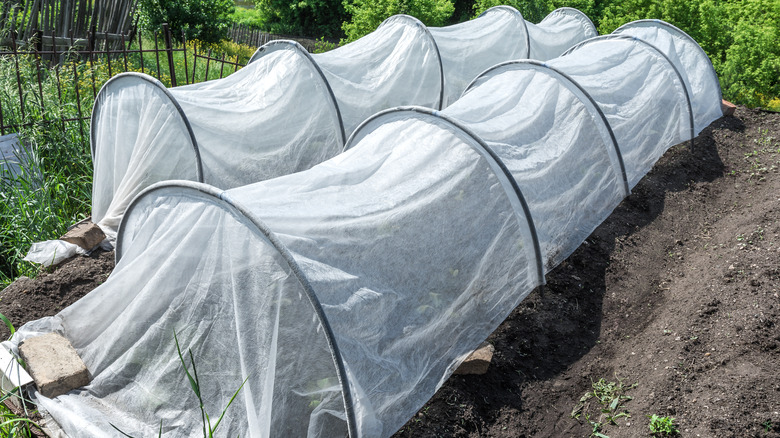Top Tips For Getting Cabbage Worms Off Your Vegetables And Out Of The Garden
We may receive a commission on purchases made from links.
If something is munching on your cabbage or broccoli in the garden, leaving big holes in the leaves and frayed edges or even devouring leaves entirely, you might have a cabbage worm problem. Cabbage worms, also known as imported cabbage worms, are on the list for the common pests for collard greens and many other leafy greens in your vegetable garden. Left to their own devices, cabbage worms can completely destroy entire crops, especially young plants. Thankfully, there are ways to prevent, treat, and contain them to save your cabbage and other greens from their insatiable appetites.
Those fuzzy, green caterpillars are the larvae of white moths with brown spots you might have seen fluttering around your garden. Those moths will lay eggs on leafy plants in the spring (usually underneath), and after hatching, the worms can grow from a speck to an inch in about 2 weeks. The caterpillars see your plants as an all-you-can-eat buffet, and they'll stick around until mid-September.
Cabbage worms are not to be confused with cabbage loopers, a green-yellow caterpillar that also loves to snack on cabbage (Brassica oleracea) plants. These worms are mostly green and often have a faint yellow stripe down the center of their backs. Not sure if it's a cabbage worm or cabbage looper causing trouble? Take a look at how they move. A cabbage looper will curve upward as it walks, like a cartoon worm, because it doesn't have a middle set of legs. Cabbage worms do, so they crawl flat.
Don't confuse cabbage worm with other pests
Cabbage looper isn't the only pest that can be confused with a cabbage worm — which may also be referred to as a cabbage white or small white. Cabbage is a yummy meal to a whole host of pests, so if you find holes in your cabbage leaves, the culprit might be a cabbage worm ... or it could be another variety of insects, like diamondback moth larvae or even a zebra caterpillar. All of these pests can cause pretty serious damage to your cabbage plant, so it's a good idea to figure out which pest you're dealing with before you start tackling the problem.
Zebra caterpillars are largely cream and black, which is the reason they're compared to zebras. In appearance, they're not similar to cabbage worms. Cabbage webworms aren't either, since they have black heads and tan bodies. So even while they do a lot of damage to cabbage plants, they don't look much like the cabbage worm, so it's easy to spot the difference.
Dimaondback moth larvae, however, are a yellowish-green, and similar in color, so they can easily be mistaken or confused for a cabbage worm. One distinctive feature of the diamondback larvae, however, is a forked rear. Also, diamondback moth larvae don't grow as long as cabbage worms. They only grow to be about a half inch long, instead of an inch. So take a close look at the worms on your plants to decide which species is causing the trouble.
What to do if you see a cabbage worm
If decide you do have cabbage worms, fear not. There's more than one way to learn how to kill green worms in a garden. First, pick off any that you see munching on plants. Also check underneath the leaves for any eggs that might not have hatched yet. Scraping them off will head off hungry caterpillars later. This is the quickest and most organic way to get rid of cabbage worms.
If you still see a lot of cabbage worms, you may want to use chemicals. You can use an organic pesticide like Bacillus thuringiensis (Bt). Just spray your plant every week or two with the compound, and it should kill the worms. Bt works by damaging the stomachs of cabbage worms and other insects. It's generally considered safe for people and other mammals, since we can eat Bt with no problem. That's why you can safely spray on plants right up until harvest. Bt can break down in sunlight, so it's best to apply it in the evening or on days with good cloud cover.
Of course, keep in mind that when you're using a chemical like this, you may inadvertently end up killing the insects you like in the garden, too. While Bt is typically not toxic to bees, it can kill the larvae and caterpillars of monarch butterflies, so before you spray, consider the impact on insects you might want to keep around the garden.
Try these non-chemical solutions to fighting cabbage worms
Of course, if you're just not keen on using potentially harsh chemicals on your vegetables period, then you can try other all-organic ways to get rid of pesky cabbage worms. First on the list is neem oil, which can work wonders. Neem oil is an all organic, non-toxic pesticide derived from the seeds of the neem tree (Azadirachta indica) that kills more than 200 different kinds of bugs as well as certain fungi and bacteria, which is why many gardeners swear by it. It's been used for centuries — both as a pesticide, but also as a cure for many ailments.
Neem oil contains the chemical azadirachtin, which interferes with insects hormones and makes it harder for insects to eat and even reproduce. You can get neem oil online, like Captain Jack's Neem Max. For it to work, you'll need to generously coat the leaves of your plant, even underneath, and usually in the evening, as the sun is setting and the bees and other good pollinators have gone home to the hive.
There are other non-chemical ways to battle cabbage worms as well. You can try to wet the leaves of your cabbage plant and sprinkle cornmeal on them. If the worms eat the meal, their stomachs can expand and then supposedly, they'll die. This is an organic strategy gardeners have used for decades.
How to prevent cabbage worms from moving in
The best way to stop an infestation, of course, is to prevent one from ever happening in the first place. If you want to protect your cabbage and broccoli from becoming a cabbage worm's next meal, consider creating a pest screening for your vegetable garden. The easiest way to do this is to use a row cover on your cabbage. Row covers are lightweight and breathable tents you can place over your plants. They allow sunlight and rain to get through, but not moths looking to lay eggs.
All you need to make one is material for a hoop, like PVC pipe or even bamboo, and some sheer fabric, like tulle, which you can get at a local fabric store. You can also buy ready-made kits online with hoops and fabric, like the Garden Hoops grow tunnel. Set row covers right after you plant seeds or seedlings, so you don't give the moths a chance to settle in. You'll need to secure the cover. If it flaps open, it'll give moths a chance to sneak in. So will a hole in the fabric, so check your row covers regularly.
Another preventative strategy is to grow plants cabbage worms hate, like celery, as a potential repellent plant. Self-seeding borage (Borago officinalis) could be another good one, so plant these pretty indigo flowers in the garden next to your cabbage. Planting thyme might help as well, since thyme disguises the smell of cabbage.
Avoid these things that can bring cabbage worms to your yard.
While you're trying to prevent a cabbage worm infestation, don't undo all your hard work by inadvertently inviting the pests in. Cabbage worm moths are attracted to all members of the Brassica family, including nasturtiums and mustard plants, so avoid planting them near your cabbage. While mustard plants can be used as an effective trap plant, you have to know it's a trap plant and make sure to kill the worms on your mustard leaves before they migrate to your cabbage. Otherwise, trap plants can backfire.
Another mistake is to scare off paper wasps or ladybugs. They prey on cabbage worms, and letting them loose in your garden can help keep the population under control. If you're killing wasps and ladybugs, you might be getting rid of your best line of defense. Draw in wasps or ladybugs to your yard by planting fava beans or cow beans in your vegetable garden. Interweave these plants with your cabbages or broccoli to bring predators closer to the cabbage worms.
While you're drawing in wasps and ladybugs, you can also be more strategic about the kind of cabbage you plant. Consider opting for red-leafed cabbage instead of green-leafed cabbage, as red leaves are less appealing to cabbage worm moths. This all might seem like a lot of work, but a multi-faceted approach is best when dealing with the destructive cabbage worm. When left unchecked, they can devour your vegetable garden.




